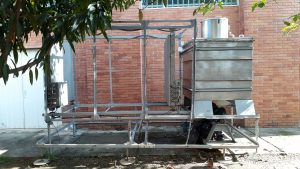The Muon Telescope
The Muon Telescope is a hybrid instrument suitable for different geophysical scenarios. MuTe employs a plastic scintillator hodoscope to determine the direction of particles impinging the detector after crossing the geophysical target. Additionally, MuTe incorporates particle-identification techniques for reducing the background noise sources. A Water Cherenkov Detector (WCD) measures the deposited energy of charged particles filtering the noise due to the soft-component of Extensive Air Showers (electrons and positrons), and of particles arriving simultaneously. Discrimination of fake events due to scattered and backwards particles is addressed using a Time-of-Flight system.
In this project, the design, construction, calibration and start-up of a muon telescope with two panels (each with 900 pixels and a detection area of 1.2 x 1.2 m2), which will allow the detection of the flow of atmospheric muons that cross the central part of the Cerro Machín volcano (departments of Tolima) in Colombia. Muons are electrically charged particles that can produce flashes of light when they strike a scintillating material. This fact will be used to detect the passage of muons through the two panels of the telescope and thus determine the path that it has followed through the volcano.
Secondly, the construction of the density profile of the central part of the volcanoes mentioned in a plane parallel to the plane of the telescope panels is proposed. This task can be carried out by estimating the energy spectrum of the muons that arrive at the telescope by means of simulations of the flux of atmospheric muons in the observation sites in the vicinity of the volcanoes, in the absence and in the presence of the volcanoes, considering a volumetric models of volcanoes with uniform density), using a model of muon energy attenuation when interacting with matter, with knowledge of the topography of the observation area that allows determining the length of the muons trajectory that have sufficient initial energy to cross the area of the volcano and, finally, with the data obtained from the detection process with the muon telescope. The difference in the flux of muons in the different trajectories that pass through the volcano compared with the results of the simulations allow to deduce the variations in the average density of the material of which it is made. It should not be forgotten that the propagation of the muons inside the detector will be determined by means of very detailed simulations of the interaction of radiation with matter based on the GEANT4 code.
The proposal is then that from the information obtained by the method described above on the density of the central part of the volcano and with the existing information obtained through other geophysical methods, it is possible to propose, complement or improve the models of the interior. the central part of the volcanoes under study in order to estimate their structure of domes, their lava conduits, weakening of flanks or other information of interest to both Geophysicists and other professionals who are dedicated to the study of volcanoes. In addition, with the realization of this project, it is intended to generate more and better scientific information that can serve in the future to complement studies of volcanic risk and danger, which in turn will eventually allow better bases for decision-making by the organisms. of Civil Protection and Disaster Prevention and Attention.
MuTe is a project financed by the Administrative Department of Science, Technology and Innovation (ColCiencias, Contract FP44842-051-2015, belonging to Call No. 658 of 2014) that seeks to design, build, calibrate and put into operation a muon detector telescope to detect the flux of atmospheric muons that cross the central part of the Cerro Machín volcano (departments of Tolima) in Colombia. The Industrial University of Santander (coordinator), the University of Tolima and the Colombian Geological Service participate in this project, with the support of the Institute of Geophysics of the National Autonomous University of Mexico.
